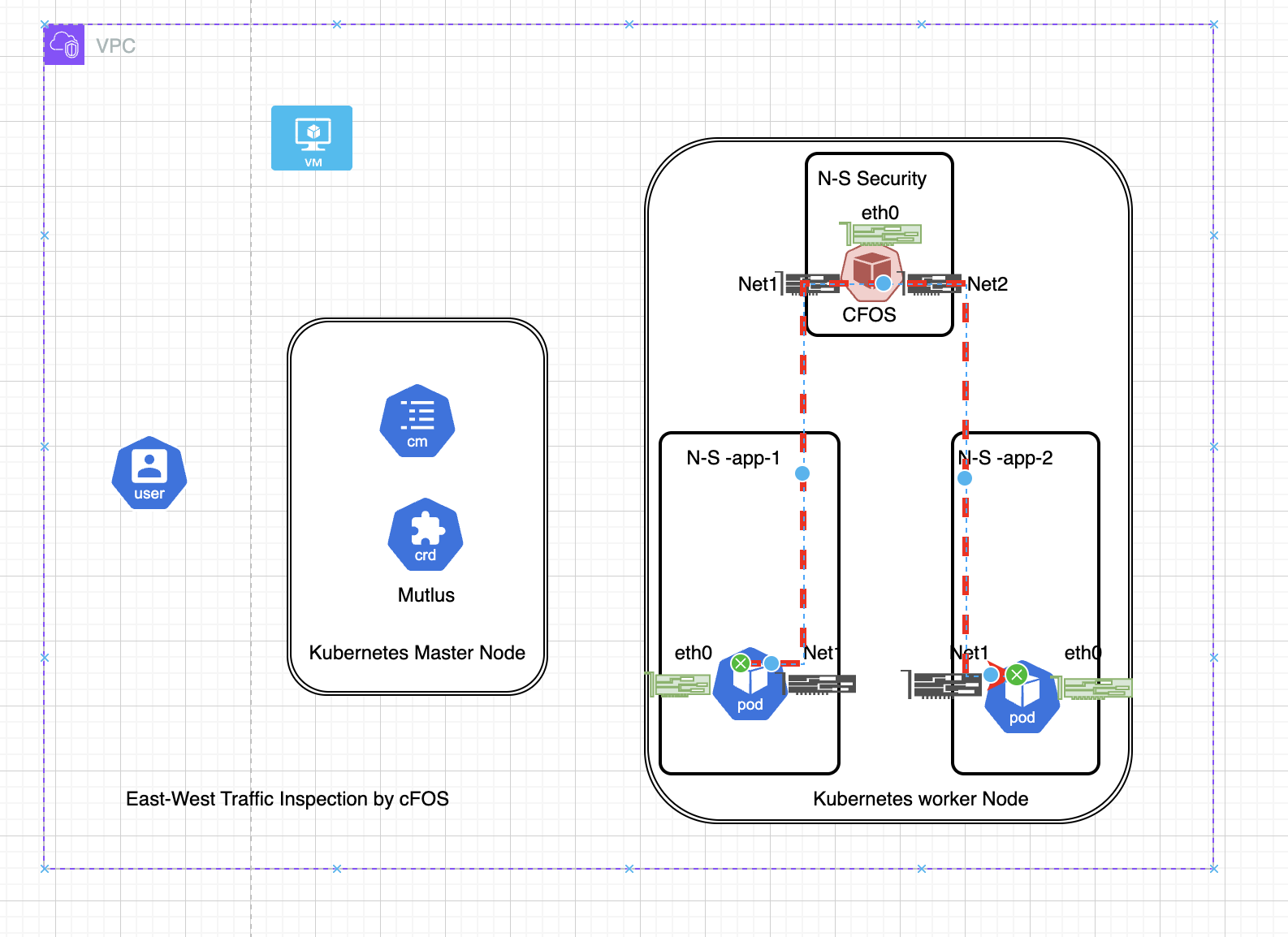Task 2 - Securing pod to pod traffic
East-West traffic in the context of container-based environments, particularly with Kubernetes, refers to the data flow between different nodes or pods within the same data center or network. This type of traffic is crucial for the performance and security of microservices architectures, where multiple services need to communicate with each other frequently.
Microservices break down applications into smaller, independent services, which increases the amount of East-West traffic. Each service might be running in different containers that need to communicate with each other.
continue from previous Task Egress with cFOS
- create firewall policy for east-west traffic
The firewall policy allow traffic from net1 to net2 inspected by firewall policy
cat << EOF | tee > net1net2cmfirewallpolicy.yaml
apiVersion: v1
kind: ConfigMap
metadata:
name: net1net2
labels:
app: fos
category: config
data:
type: partial
config: |-
config firewall policy
edit 10
set utm-status enable
set srcintf "net1"
set dstintf "net2"
set srcaddr "all"
set dstaddr "all"
set service "ALL"
set ssl-ssh-profile "deep-inspection"
set av-profile "default"
set webfilter-profile "default"
set ips-sensor "high_security"
set logtraffic all
next
end
config firewall policy
edit 11
set utm-status enable
set srcintf "net2"
set dstintf "net1"
set srcaddr "all"
set dstaddr "all"
set service "ALL"
set ssl-ssh-profile "deep-inspection"
set av-profile "default"
set webfilter-profile "default"
set ips-sensor "high_security"
set logtraffic all
next
end
EOF
kubectl apply -f net1net2cmfirewallpolicy.yaml -n cfosegress- get ip from diag100 and diag200
diag200ip=$(k get po/diag200 -n app-1 -o jsonpath='{.metadata.annotations}' | jq -r '.["k8s.v1.cni.cncf.io/network-status"]' | jq -r '.[1].ips[0]')
echo $diag200ip
diag100ip=$(k get po/diag100 -n app-2 -o jsonpath='{.metadata.annotations}' | jq -r '.["k8s.v1.cni.cncf.io/network-status"]' | jq -r '.[1].ips[0]')
echo $diag100ip- check connectivity between diag100 to diag200
k exec -it po/diag100 -n app-2 -- ping -c 5 $diag200ip
k exec -it po/diag200 -n app-1 -- ping -c 5 $diag100ip- Send malicious traffic
k exec -it po/diag100 -n app-2 -- curl --max-time 5 -H "User-Agent: () { :; }; /bin/ls" http://$diag200ip
k exec -it po/diag200 -n app-1 -- curl --max-time 5 -H "User-Agent: () { :; }; /bin/ls" http://$diag100ip- Check Result
podname=$(kubectl get pod -n cfosegress -l app=cfos -o jsonpath='{.items[*].metadata.name}')
kubectl exec -it po/$podname -n cfosegress -- tail -f /data/var/log/log/ips.0expected output
kubectl exec -it po/$podname -n cfosegress -- tail -f /data/var/log/log/ips.0
Defaulted container "cfos7210250-container" out of: cfos7210250-container, init-myservice (init)
date=2024-06-27 time=09:18:00 eventtime=1719479880 tz="+0000" logid="0419016384" type="utm" subtype="ips" eventtype="signature" level="alert" severity="critical" srcip=10.1.200.22 dstip=34.117.186.192 srcintf="net1" dstintf="eth0" sessionid=2 action="dropped" proto=6 service="HTTP" policyid=100 attack="Bash.Function.Definitions.Remote.Code.Execution" srcport=33352 dstport=80 hostname="ipinfo.io" url="/" direction="outgoing" attackid=39294 profile="high_security" incidentserialno=265289730 msg="applications3: Bash.Function.Definitions.Remote.Code.Execution"
date=2024-06-27 time=09:37:35 eventtime=1719481055 tz="+0000" logid="0419016384" type="utm" subtype="ips" eventtype="signature" level="alert" severity="critical" srcip=10.1.100.22 dstip=10.1.200.22 srcintf="net2" dstintf="net1" sessionid=10 action="dropped" proto=6 service="HTTP" policyid=11 attack="Bash.Function.Definitions.Remote.Code.Execution" srcport=46952 dstport=80 hostname="10.1.200.22" url="/" direction="outgoing" attackid=39294 profile="high_security" incidentserialno=265289733 msg="applications3: Bash.Function.Definitions.Remote.Code.Execution"
date=2024-06-27 time=09:37:41 eventtime=1719481061 tz="+0000" logid="0419016384" type="utm" subtype="ips" eventtype="signature" level="alert" severity="critical" srcip=10.1.200.22 dstip=10.1.100.22 srcintf="net1" dstintf="net2" sessionid=11 action="dropped" proto=6 service="HTTP" policyid=10 attack="Bash.Function.Definitions.Remote.Code.Execution" srcport=40358 dstport=80 hostname="10.1.100.22" url="/" direction="outgoing" attackid=39294 profile="high_security" incidentserialno=265289734 msg="applications3: Bash.Function.Definitions.Remote.Code.Execution"- clean up
kubectl delete namespace app-1
kubectl delete namespace app-2
kubectl delete namespace cfosegress- delete all resource
rg=$(az group list --query "[?contains(name, '$(whoami)') && contains(name, 'workshop')].name" -o tsv)
vmNames=$(az vm list -g $rg --query "[].name" -o tsv)
for vmName in $vmNames; do
az vm delete --name $vmName -g $rg --yes
done
diskNames=$(az disk list --resource-group "$rg" --query "[].name" -o tsv)
for diskName in $diskNames; do
az disk delete --name "$diskName" --resource-group $rg --yes
done
nics=$(az network nic list -g $rg -o tsv)
for nic in $nics; do
az network nic delete --name $nic -g $rg
done
publicIps=$(az network public-ip list -g $rg -o tsv)
for publicIp in $publicIps; do
az network public-ip delete --name $publicIp -g $rg
done
vnets=$(az network vnet list -g $rg -o tsv)
for vnet in $vnets; do
az network vnet delete --name $vnet -g $rg
done
nsgs=$(az network nsg list -g $rg -o tsv)
for nsg in $nsgs; do
az network nsg delete --name $nsg -g $rg
done
az aks delete -n $(whoami)-aks-cluster -g $rg